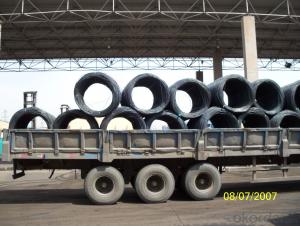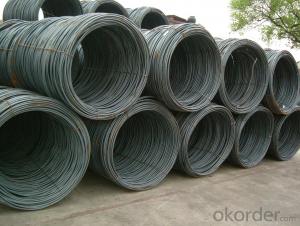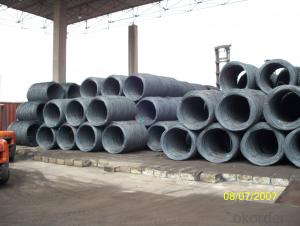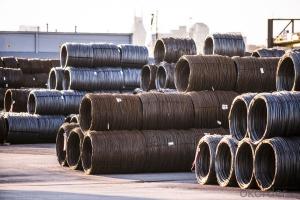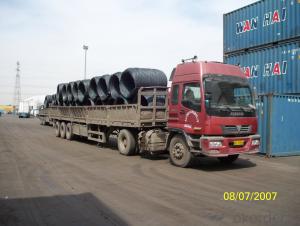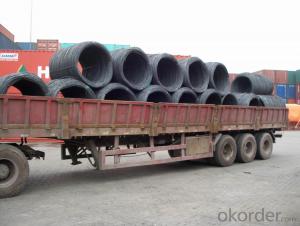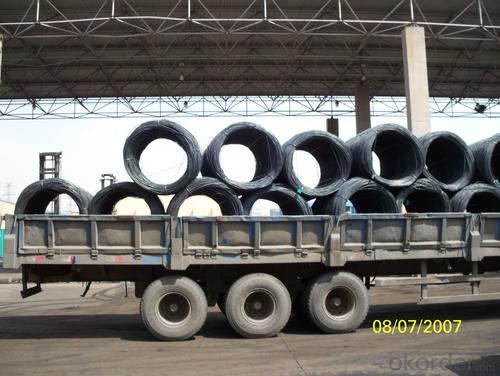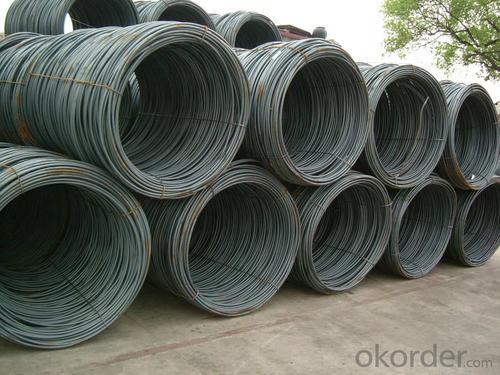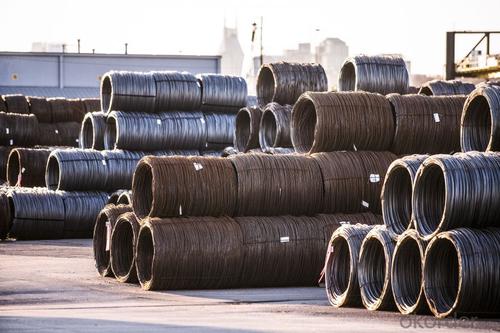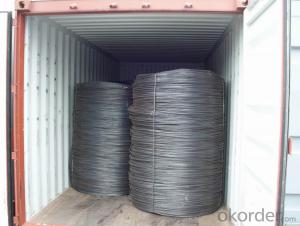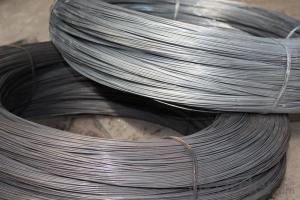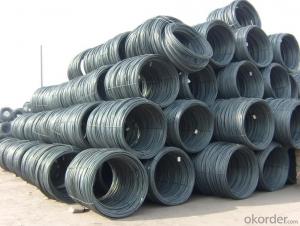SAE1006Cr Carbon Steel Wire Rod 7.5mm for Welding
- Loading Port:
- Shanghai
- Payment Terms:
- TT OR LC
- Min Order Qty:
- 100 m.t
- Supply Capability:
- 30000 m.t/month
OKorder Service Pledge
OKorder Financial Service
You Might Also Like
Specification
Description of SAE1006Cr Carbon Steel Wire Rod 7.5mm for Welding:
OKorder is offering Color Coated Steel Coil Prepainted Steel Coil at great prices with worldwide shipping. Our supplier is a world-class manufacturer of steel, with our products utilized the world over. OKorder annually supplies products to European, North American and Asian markets. We provide quotations within 24 hours of receiving an inquiry and guarantee competitive prices.
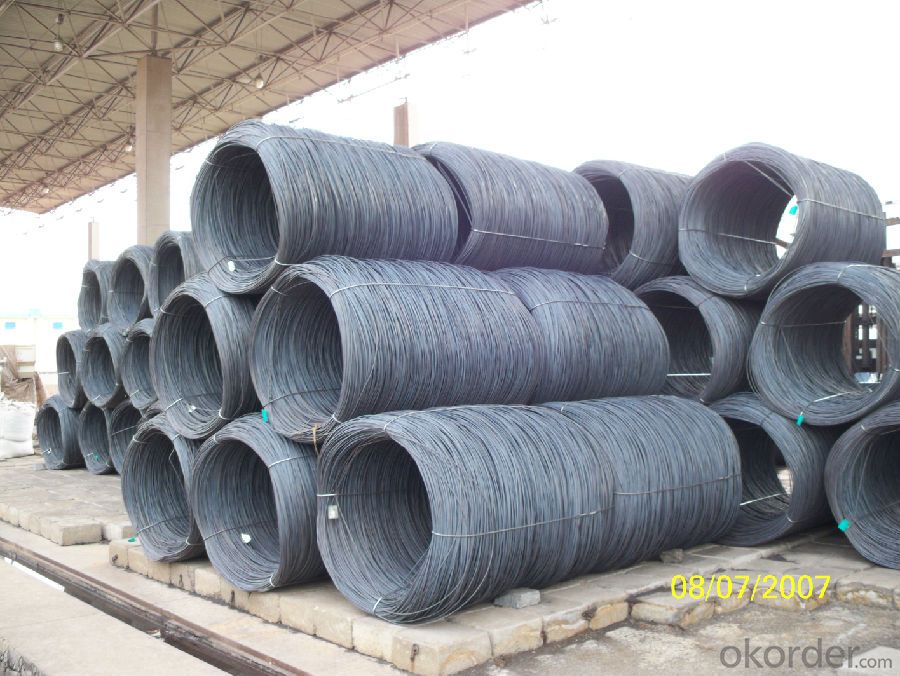
Applications of SAE1006Cr Carbon Steel Wire Rod 7.5mm for Welding:
Color Coated Steel Coil Prepainted Steel Coil are ideal for structural applications and are widely used in the construction of buildings and bridges, and the manufacturing, petrochemical, and transportation industries.
Main Product Features of SAE1006Cr Carbon Steel Wire Rod 7.5mm for Welding:
· Premium quality
· Prompt delivery & seaworthy packing (30 days after receiving deposit)
· Corrosion resistance
· Can be recycled and reused
· Mill test certification
· Professional Service
· Competitive pricing
Specifications of SAE1006Cr Carbon Steel Wire Rod 7.5mm for Welding:
PPGI:
1, Introduction: Color coated steel coils(sheets), i. E. PPGI, also called prepainted steel coils(sheets), are made of galvanized steel coils(sheets) with polymer coatings as surface. It's a new enclosure material and building board with characteristics of light-weighted, heat preserved&insulated, easily installed with bright colors.
2, Production Process: Pretreatment(Degreasing)_Drying_Chromating_Paint Basic Oil_Cooling_Drying_Color Coating_Cooling_Film-covering_Rolling Up
3, Characteristics:
Good at corrosion resistence. Besides zinc coating of the basic plate of galvanized steel sheet, the color coating as the surface has double lifetime to ensure better anticorrosion effect.
With excellent cold bending molded manufacturablity, PPGI products can be processed or directly used as final product. As being light-weighted and conveniently transported, they're widly used to replace wood to save energy.
4.There're thousands of colors can be chosen as per different application. Any color plays well in decoration.
No pollution with high recycling rate, PPGI coils and sheets are strongly recommended as enviroment-friendly products by the government.
5, eye bands and 4 circumferential bands in steel, galvanized metal fluted rings on inner and outer edges, galvanized.
| commodity | SAE1006Cr Carbon Steel Wire Rod 7.5mm for Welding |
| Techinical Standard: | JIS G3302-1998, EN10142/10137, ASTM A755 |
| grade | Q195,Q215,Q235,SAE1006,SAE1008 SAE1006Cr |
| Types: | Mesh welding |
| Base metal | galvanized, galvalume, cold rolled steel |
| Thickness | 0.14-1.0mm(0.16-0.8mm is the most advantage thickness) |
| Width | 610/724/820/914/1000/1200/1219/1220/1250mm |
| Type of coating: | PE, SMP, PVDF |
| Zinc coating | Z60-150g/m2 or AZ40-100g/m2 |
| Top painting: | 5 mic. Primer + 15 mc. R. M. P. |
| Back painting: | 5-7 mic. EP |
| Color: | According to RAL standard |
| ID coil | 508mm610mm |
| Coil weight: | 2--3MT |
| Package: | Properly packed for ocean freight exportation in 20'containers |
| Application: | Industrial panels, roofing and siding for painting/automobile |
| Price terms | FOB, CFR, CIF |
| Payment terms | 20%TT in advance+80% TT or irrevocable 80%L/C at sight |
| delivery time | 25 days after recepit of 20% TT |
| Remarks | Insurance is all risks |
| MTC 3.1 will be handed on with shipping documents | |
| We accept SGS certificatation test |
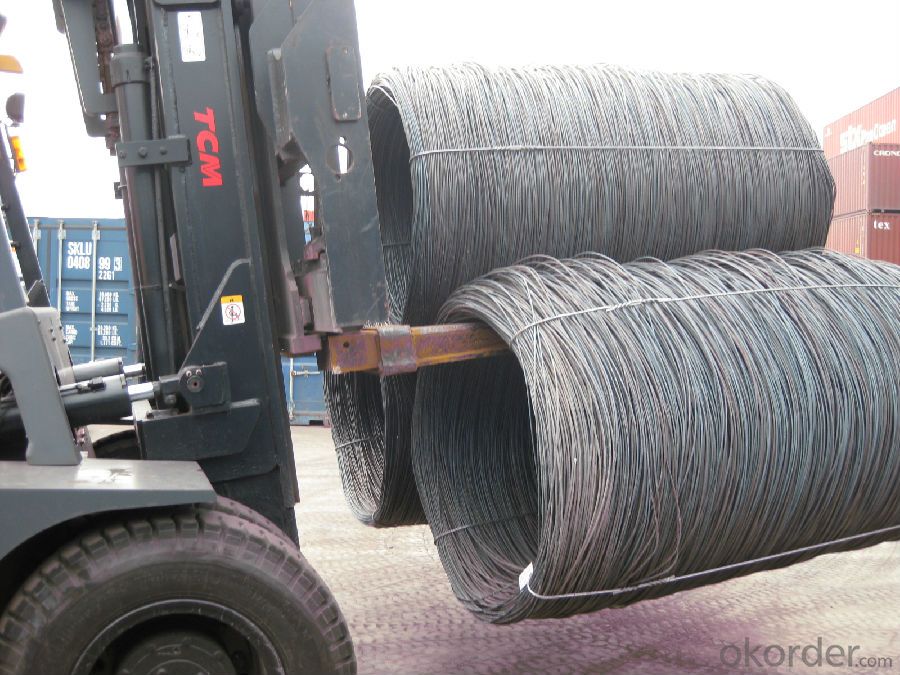
FAQ of SAE1006Cr Carbon Steel Wire Rod 7.5mm for Welding:
Q1: Why buy Materials & Equipment from OKorder.com?
A1: All products offered byOKorder.com are carefully selected from China's most reliable manufacturing enterprises. Through its ISO certifications, OKorder.com adheres to the highest standards and a commitment to supply chain safety and customer satisfaction.
Q2: How do we guarantee the quality of our products?
A2: We have established an advanced quality management system which conducts strict quality tests at every step, from raw materials to the final product. At the same time, we provide extensive follow-up service assurances as required.
Q3: How soon can we receive the product after purchase?
A3: Within three days of placing an order, we will begin production. The specific shipping date is dependent upon international and government factors, but is typically 7 to 10 workdays.
Q4: What makes stainless steel stainless?
A4: Stainless steel must contain at least 10.5 % chromium. It is this element that reacts with the oxygen in the air to form a complex chrome-oxide surface layer that is invisible but strong enough to prevent further oxygen from "staining" (rusting) the surface. Higher levels of chromium and the addition of other alloying elements such as nickel and molybdenum enhance this surface layer and improve the corrosion resistance of the stainless material.
Q5: Can stainless steel rust?
A5: Stainless does not "rust" as you think of regular steel rusting with a red oxide on the surface that flakes off. If you see red rust it is probably due to some iron particles that have contaminated the surface of the stainless steel and it is these iron particles that are rusting. Look at the source of the rusting and see if you can remove it from the surface.
- Q: Can steel wire rod be used in the production of springs?
- Yes, steel wire rod can be used in the production of springs. Steel wire rod is commonly used due to its high strength and durability, which are essential characteristics for springs that need to withstand repeated stress and maintain their shape over time.
- Q: What are the different types of wire rods for reinforcement made from steel wire rod?
- Wire rods for reinforcement, which are made from steel, come in several different types. These include: 1. Mild Steel Wire Rods: The most commonly used type, these wire rods are made from low carbon steel. They offer good strength and durability, making them suitable for various applications. 2. High Tensile Steel Wire Rods: Specifically designed to provide greater strength and resistance to tension, these wire rods are made from high carbon steel. They are commonly used in construction projects or the manufacturing of heavy machinery. 3. Stainless Steel Wire Rods: Made from corrosion-resistant stainless steel, these wire rods are commonly used in environments prone to corrosion, like coastal areas or chemical processing plants. 4. Galvanized Steel Wire Rods: To protect against corrosion, these wire rods are coated with a layer of zinc. They are often used in outdoor applications or areas with high moisture levels. 5. Copper-Clad Steel Wire Rods: These wire rods have a steel core with a layer of copper cladding. They combine the strength and durability of steel with the excellent electrical conductivity of copper, making them ideal for electrical wiring or grounding systems. In conclusion, the different types of wire rods for reinforcement made from steel offer a range of properties and characteristics to suit various applications and environments.
- Q: What are the applications of steel wire rods?
- Steel wire rods are widely used in various applications due to their strength, flexibility, and durability. Some of the common applications of steel wire rods are: 1. Construction: Steel wire rods are extensively used in the construction industry for reinforcing concrete structures. They are used to create steel mesh, stirrups, and rebar, which significantly enhance the strength and stability of concrete buildings, bridges, and other infrastructure. 2. Automotive industry: Steel wire rods are indispensable in the automotive sector. They are used to manufacture springs, suspension systems, tire reinforcement, and seat frames, providing the necessary strength and resilience for various automotive components. 3. Manufacturing: Steel wire rods are utilized in the manufacturing of a wide range of products such as nails, screws, bolts, and wire mesh. These products find applications in the construction industry, furniture manufacturing, and general fabrication processes. 4. Electrical industry: Steel wire rods are employed in the electrical industry for the production of cables and conductors. They form the core of electrical cables, ensuring the efficient transmission of electricity over long distances. 5. Agricultural sector: Steel wire rods are used in the agricultural sector for fencing and animal enclosures. They provide a strong and durable barrier, ensuring the security and safety of livestock and crops. 6. Packaging industry: Steel wire rods are utilized in the packaging industry for the production of wire-based packaging materials such as wire baskets, racks, and crates. These products provide a sturdy and reliable solution for transporting and storing various goods. 7. Wire products: Steel wire rods are also transformed into a wide array of wire products, including wire ropes, springs, piano wires, and welding electrodes. These products find applications in diverse industries such as mining, marine, manufacturing, and construction. In summary, the applications of steel wire rods are vast and diverse, ranging from construction and automotive to manufacturing and electrical industries. Their strength, flexibility, and durability make them indispensable in numerous sectors, playing a crucial role in enhancing the performance and reliability of various products and structures.
- Q: What are the common applications of galvanized and oil tempered steel wire rod?
- Galvanized steel wire rod is commonly used in a variety of applications due to its protective zinc coating. The galvanization process involves applying a layer of zinc to the surface of the steel wire rod, which provides excellent corrosion resistance. This makes galvanized steel wire rod ideal for applications where the material will be exposed to moisture, chemicals, or harsh environments. Some common applications of galvanized steel wire rod include: 1. Fencing and wire mesh: Galvanized steel wire rod is widely used in the construction of fences and wire mesh. The zinc coating helps to prevent rust and corrosion, ensuring the longevity and durability of the fencing or mesh. 2. Construction: Galvanized steel wire rod is used in various construction applications, such as concrete reinforcement. The added strength and corrosion resistance of galvanized steel make it an excellent choice for reinforcing structures and providing stability. 3. Automotive industry: Galvanized steel wire rod is used in the manufacturing of automotive parts and components. It is often utilized in the production of springs, suspension systems, and wire harnesses due to its high strength and corrosion resistance. 4. Electrical applications: Galvanized steel wire rod is commonly used in electrical applications, such as cable armor and grounding wires. The zinc coating provides an extra layer of protection against corrosion, ensuring the safety and reliability of electrical systems. On the other hand, oil tempered steel wire rod is a high-strength material that has been treated with heat and oil to enhance its mechanical properties. This process involves heating the steel wire rod to a specific temperature and then quenching it in oil. The result is a wire rod with improved toughness, durability, and resistance to fatigue. Some common applications of oil tempered steel wire rod include: 1. Springs: Oil tempered steel wire rod is widely used in the manufacturing of springs, such as coil springs, suspension springs, and valve springs. The high strength and excellent fatigue resistance of oil tempered steel make it ideal for applications that require a reliable and long-lasting spring. 2. Mechanical components: Oil tempered steel wire rod is used in the production of various mechanical components, such as shafts, gears, and fasteners. Its high strength and toughness make it suitable for applications where durability and reliability are essential. 3. Automotive industry: Oil tempered steel wire rod is extensively used in the automotive industry for applications such as seat frames, seat belts, and suspension systems. The superior mechanical properties of oil tempered steel ensure the safety and performance of automotive components. 4. Industrial equipment: Oil tempered steel wire rod is employed in a wide range of industrial equipment, including conveyor belts, wire ropes, and crane cables. Its high tensile strength and resistance to fatigue make it an ideal material for handling heavy loads and enduring demanding conditions. Overall, both galvanized and oil tempered steel wire rods have their unique applications and advantages. Galvanized steel is primarily used for its corrosion resistance, while oil tempered steel is selected for its high strength and durability.
- Q: How does the hardness of steel wire rod vary with different wire drawing processes?
- The hardness of steel wire rod can differ depending on the wire drawing processes employed, owing to several factors. To begin with, the hardness of the steel wire rod is influenced by the reduction in diameter that occurs during the wire drawing process. As the wire is pulled through a series of dies, the material undergoes plastic deformation. This deformation causes the grains within the steel to elongate and align in the direction of the wire, resulting in increased hardness. The extent to which the diameter is reduced directly impacts the amount of deformation and, consequently, the hardness of the wire rod. Moreover, the speed at which the wire is drawn plays a role in determining its hardness. Higher drawing speeds tend to impose more strain on the material, leading to greater deformation and higher hardness. Conversely, slower drawing speeds may result in less deformation and lower hardness. Furthermore, the heat generated during the wire drawing process can affect the hardness of the steel wire rod. Friction between the wire and the dies generates heat, which can cause the material to soften. If the wire is not adequately cooled during the drawing process, its hardness may decrease. Conversely, controlled cooling techniques can be utilized to maintain or enhance the hardness of the wire rod. Lastly, the lubrication chosen for the wire drawing process can impact the hardness of the steel wire rod. Appropriate lubrication reduces the friction between the wire and the dies, minimizing heat generation and preventing surface damage. This allows for more controlled deformation, resulting in the desired level of hardness. In conclusion, the hardness of steel wire rod varies depending on the wire drawing processes employed, due to factors such as the extent of diameter reduction, drawing speed, heat generation, and lubrication. These factors must be carefully considered and controlled to achieve the desired hardness in the final wire product.
- Q: How is steel wire rod tested for resistance to crevice corrosion?
- Steel wire rod is tested for resistance to crevice corrosion through various methods, including visual inspection, weight loss measurement, electrochemical testing, and exposure to corrosive environments. These tests help determine the susceptibility of the steel wire rod to crevice corrosion, which is crucial for ensuring its durability and performance in different applications.
- Q: What are the main factors influencing the choice of steel wire rod warranty?
- The main factors influencing the choice of steel wire rod warranty are the quality of the steel wire rod, the reputation of the manufacturer, and the terms and conditions of the warranty itself. Firstly, the quality of the steel wire rod plays a significant role in the choice of warranty. Buyers would prefer a higher quality product that is less likely to have defects or issues, thus reducing the need for warranty claims. The overall strength, durability, and performance of the steel wire rod are crucial factors in determining the level of confidence in the product and, subsequently, the warranty. Secondly, the reputation of the manufacturer also influences the choice of warranty. A manufacturer with a proven track record of producing high-quality steel wire rods and providing reliable warranties is more likely to instill trust in the buyer. Positive reviews, testimonials, and references from other customers can contribute to the decision-making process, as they provide insights into the manufacturer's commitment to customer satisfaction and after-sales service. Lastly, the terms and conditions of the warranty itself are an essential factor. Buyers consider factors such as the duration of the warranty, the coverage it provides, and any limitations or exclusions mentioned in the warranty documentation. A longer warranty period and comprehensive coverage, including protection against manufacturing defects or premature failure, are often preferred. Additionally, factors like the process for filing warranty claims, the responsiveness of the manufacturer's customer service, and the ease of warranty fulfillment are also taken into account. In summary, the main factors influencing the choice of steel wire rod warranty include the quality of the product, the reputation of the manufacturer, and the terms and conditions of the warranty. Buyers prioritize a high-quality product, a reputable manufacturer, and a warranty with favorable terms and comprehensive coverage.
- Q: How is steel wire rod used in the manufacturing of reinforcing mesh?
- Steel wire rod is used in the manufacturing of reinforcing mesh by being processed and formed into a grid-like pattern to create a strong and durable reinforcement material. The wire rod is first straightened, then cut and welded together to form the desired mesh shape. This reinforcing mesh is then used in concrete structures, such as buildings, bridges, and roadways, to enhance their strength and resistance to cracking and deformation.
- Q: What are the different grain size measurement methods for steel wire rod?
- Steel wire rod is commonly measured using various grain size measurement methods. These methods provide crucial information about the microstructure and mechanical properties of the steel. One method widely utilized is the ASTM E112 standard, which employs a microscope to measure the average grain size. To apply this method, a metallographic sample is prepared and polished to a mirror-like finish. Subsequently, the sample is etched to reveal the grain boundaries. Under a microscope, the grain boundaries are then traced and counted to determine the average grain size. Another technique is the Sieve Analysis method, frequently employed to determine the grain size distribution in steel wire rod. This method entails sieving a representative sample of the wire rod through a series of progressively smaller mesh sieves. The weight of material retained on each sieve is measured, and the grain size distribution is determined based on the percentage of retained material. The Laser Diffraction method is another frequently used approach for measuring grain size in steel wire rod. In this method, a suspension of wire rod particles is subjected to a laser beam, and the resulting scattering pattern is measured. Particle size can be determined based on the diffraction pattern, allowing for the calculation of the grain size distribution. Additional methods include the Electron Backscatter Diffraction (EBSD) method, which utilizes an electron microscope to determine crystallographic orientation and grain boundaries in the wire rod, and the X-ray Diffraction (XRD) method, which measures the angle of X-ray diffraction to determine crystallographic structure and grain size. Each of these grain size measurement methods possesses distinct advantages and limitations. The choice of method depends on factors such as the desired level of accuracy, the type of steel wire rod being analyzed, and the available equipment and expertise.
- Q: How is steel wire rod used in the production of wire for springs in furniture?
- Steel wire rod, an essential raw material in furniture spring wire production, is typically made from high-quality steel chosen for its strength and durability. To manufacture springs, the wire rod undergoes a series of processes. Initially, it is heated and then passed through dies to gradually reduce its diameter, a process known as drawing. This improves the wire's tensile strength, flexibility, and surface finish. Once the desired thickness is achieved, the wire is coiled onto spools and sent to the spring production facility. There, it undergoes further processing to create different types of springs for furniture. When it comes to furniture springs, the wire is typically coiled into helical shapes. The coiling process can be done manually or with specialized machines, depending on the production scale. The wire's high tensile strength ensures that the springs can withstand the weight and pressure exerted when someone sits or lies on the furniture. Once the springs are formed, they are attached to the furniture frame using various techniques such as tying, stapling, or welding. These springs play a crucial role in providing support and comfort, ensuring a pleasant seating or sleeping experience for users. In conclusion, steel wire rod is crucial for producing high-quality springs that can withstand the demands placed on them in furniture. With its exceptional strength and durability, it enhances the overall user experience by providing necessary support and comfort.
Send your message to us
SAE1006Cr Carbon Steel Wire Rod 7.5mm for Welding
- Loading Port:
- Shanghai
- Payment Terms:
- TT OR LC
- Min Order Qty:
- 100 m.t
- Supply Capability:
- 30000 m.t/month
OKorder Service Pledge
OKorder Financial Service
Similar products
Hot products
Hot Searches
Related keywords
